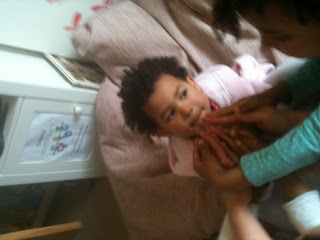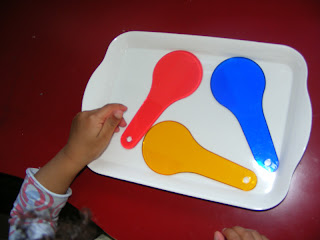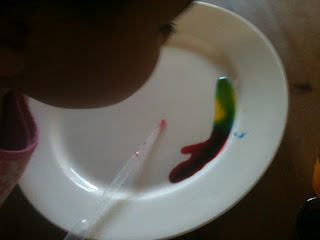We explored the theory of plate tectonics this week, which was a great excuse to break out the biscuits : )
We started by drawing on an orange - I explained that the surface of the earth is abit like an orange peel but unlike an orange its not made up of one piece but of lots of smaller pieces joined together called plates - we researched the main plates and they drew them onto a world map.
I then used the biscuits to demonstrate the different types of plate boundaries - convergent, divergent and tranformative and if they could demonstrate and name one they could eat it (needless to say they got them all right).
They worked with some 3 part cards and then played a game where they would do a specific hand action each time a type of boundry was called out,
My favourite hand action has to be the 'layered hands' for sea floor spreading at a divergent boundry. One child starts by pushing their hands up through the 'sea floor' person forcing their hands slightly apart, then the next child forces their hands up the middle and so on.
escapade: n. a piece of daring or reckless behaviour. How many times have you been labelled as mad or reckless because you homeschool? Well I say its time to break down those notions - Bring on the Madness !
Friday, 29 June 2012
Wednesday, 27 June 2012
Geography map game
Tulip has had alot of fun playing continent games with Rose.
She decided that she would remove a continent from the puzzle while Rose's eyes were closed and ask her to open them and tell her what she had removed.
This naturally progressed to them having to guess what had been removed by touch : )
She decided that she would remove a continent from the puzzle while Rose's eyes were closed and ask her to open them and tell her what she had removed.
This naturally progressed to them having to guess what had been removed by touch : )
Wednesday, 20 June 2012
Tot trays
Rose has been very excited to have her 'school room' back - especially as she has easy access to her trays.
She spent most of yesterday working with her sound/no sound tray (some of the bells have been stuffed with cotton wool to muffle them),
working with her letter b sound box,
extending her colour mixing using the colour paddles,
and working with the inset trays, drawing around shapes.
She spent most of yesterday working with her sound/no sound tray (some of the bells have been stuffed with cotton wool to muffle them),
working with her letter b sound box,
extending her colour mixing using the colour paddles,
and working with the inset trays, drawing around shapes.
Thursday, 14 June 2012
Schooling with sick kids :(
This week various children have suffered with illness, so we've taken things a little slower but still managed to squeeze some educational activities in.
We've played math, insect, human body and geography games,
explored colour mixing,
worked on lots of crafts,
read loads of books and explored botany - which is just a fancy way of saying we played outside : )
They were very impressed by the flower closing its petals at night so they did abit of reading around this.
They also counted how many flowers this bee visited (they got to 70 before they got bored).
We've played math, insect, human body and geography games,
explored colour mixing,
read loads of books and explored botany - which is just a fancy way of saying we played outside : )
They were very impressed by the flower closing its petals at night so they did abit of reading around this.
They also counted how many flowers this bee visited (they got to 70 before they got bored).
Friday, 8 June 2012
School Room Upgrade - handmade
As promised here is our new and improved schoolroom.
Working round the room - on the front of the door I keep our current scripture for memorisation, periodic table poster and any other posters relevant to our current theme.
I store all the remaining posters on the back of the door, using some bull dog clips and two stick on hooks, along with the calender.
I've used the dead space behind the door for some floating bookshelves (free plans from Ana White) that still need painting : (
The creative/nature table is still by the entrance and I've placed the beanbag to the side for reading (or hopefully for me to crash on while they all work)
I've moved the blackboard off the wall and put it on the fireplace so it's easier for them to reach,
The window ledge offers some great storage for me and an 'in tray' for all finished work.
The Montessori shelves are next to them - along with our continent boxes, work mats and some paper storage (the plastic box is a science box containing various odds and ends they might need - elastic bands, filter paper, litmus paper, goggles etc.)
Lilly and Sunflower's new desk, with the floating bookshelves holding all their reference materials and the computer. (both desk and shelf plans are from Ana White).
Tulip decided to assist in making this desk.
The girls are very happy with the new set up and I think it makes our small room look alot bigger.
All it needs now is a new coat of paint - looks like I'll be having a fun weekend.
Working round the room - on the front of the door I keep our current scripture for memorisation, periodic table poster and any other posters relevant to our current theme.
I store all the remaining posters on the back of the door, using some bull dog clips and two stick on hooks, along with the calender.
The creative/nature table is still by the entrance and I've placed the beanbag to the side for reading (or hopefully for me to crash on while they all work)
I've moved the blackboard off the wall and put it on the fireplace so it's easier for them to reach,
I built a new set of 'theme' shelves (again from Ana White) and used an old map for the backing. It displays some activities and books for free exploration. (also provides a high and safe storage space for some of the more fragile science equipment like our microscope)
Tulip and Rose have requested their old desk back and Rose's workboxes sit underneath (all the others requested workbox folder files instead)The window ledge offers some great storage for me and an 'in tray' for all finished work.
The Montessori shelves are next to them - along with our continent boxes, work mats and some paper storage (the plastic box is a science box containing various odds and ends they might need - elastic bands, filter paper, litmus paper, goggles etc.)
Lilly and Sunflower's new desk, with the floating bookshelves holding all their reference materials and the computer. (both desk and shelf plans are from Ana White).
Tulip decided to assist in making this desk.
The girls are very happy with the new set up and I think it makes our small room look alot bigger.
All it needs now is a new coat of paint - looks like I'll be having a fun weekend.
Friday, 1 June 2012
pH / Acid's and Alkali's unit
We started the unit by watching a couple of brainpop videos that describe Acid and Alkali and the pH scale (potential of Hydrogen)
They followed this by writing up what they had learnt and doing a venn diagram activity
Once completed we moved on to the practical activities - first we made red cabbage water
and used it to identify the different pH of various household items (lemonade, vinegar, baking powder, cream of tartar, laundry powder and lemons)
we also compared the results from litmus paper to our red cabbage water results. (as you can see they arranged it in ascending pH order)
They worked on using acids and bases to neutralise each other
first they tested to make sure they had an acid and base
then they used them to neutralise each other (we used baking soda and vinegar)- the foaming is caused by the release of carbon dioxide and you are left with a salt and water,
when they tested with litmus paper the remaining liquid came out at pH7 or neutral (same as water).
They seemed to really enjoy this activity and repeated it 5 times : )
The final activity was to see how acid affects metal which provided a great opportunity to learn all about lab safety and the hazard symbols.
They followed this by writing up what they had learnt and doing a venn diagram activity
Once completed we moved on to the practical activities - first we made red cabbage water
and used it to identify the different pH of various household items (lemonade, vinegar, baking powder, cream of tartar, laundry powder and lemons)
we also compared the results from litmus paper to our red cabbage water results. (as you can see they arranged it in ascending pH order)
They worked on using acids and bases to neutralise each other
first they tested to make sure they had an acid and base
then they used them to neutralise each other (we used baking soda and vinegar)- the foaming is caused by the release of carbon dioxide and you are left with a salt and water,
when they tested with litmus paper the remaining liquid came out at pH7 or neutral (same as water).
They seemed to really enjoy this activity and repeated it 5 times : )
The final activity was to see how acid affects metal which provided a great opportunity to learn all about lab safety and the hazard symbols.
Subscribe to:
Comments (Atom)























































